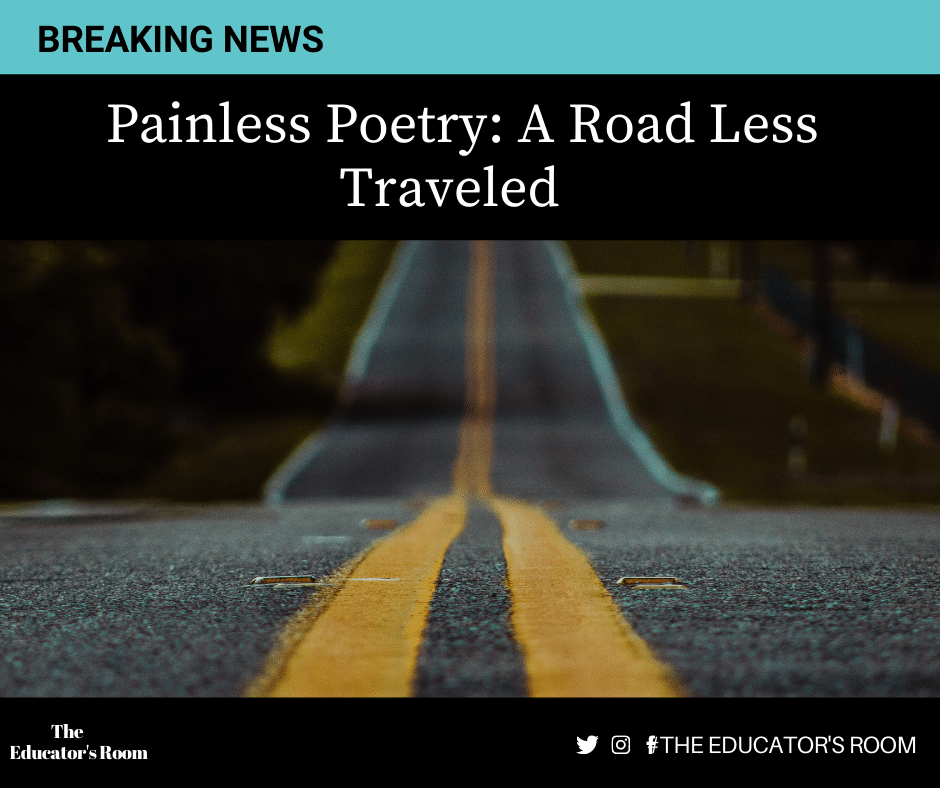Painless Poetry
“Gross! I hate this stuff!”
“This is too hard, I don’t wanna do it!”
“It never makes sense to me, it’s all so weird.”
Then the calm voice of reason speaks- “Ladies, we have to teach it, it’s part of the curriculum.”
What is this dreaded standard? Poetry.
That single word would often strike fear into my fellow English teachers because it is difficult and sometimes an unenjoyable unit of study. I was the one in the group grinning because I enjoy almost every unit we teach throughout the year. My colleagues also lamented when we had to kick up our grammar lessons as well. Well, except me. Small confession, I participated in a diagramming club in high school my English teacher sponsored. So I tend to be the one my colleagues come to in creating the “fun” lessons to engage the students because if it is not fun, they are not interested. I suppose the same could be said for our students.
To begin our poetry unit, we do the key vocabulary components that are scattered around the room but not in words. Instead, the students have a handout with a fill in the blank document and they have to use a device that can activate the QR code to retrieve the answers. It is just plain vocabulary, but if you gamify it a bit, they will participate. We do not dive right in, we discuss some of the terms first to be sure we are on the same page.
Then I tell them to listen carefully while I recite a poem to see how many metaphors, similes, allusions, etc. they hear and keep a tally. To kick us off, I stand at the front of my room and begin reciting these words – “I used to rule the world, seas would rise when I gave the word. Now in the morning, I sleep alone, sweep the streets I used to own.” I try not to make eye contact with the students because I would giggle at their quizzical faces trying to remember where they’ve heard this before. I finish out the rest of the verses “I hear Jerusalem bells are ringing, Roman Cavalry choirs are singing. Be my mirror my sword and shield, missionaries in a foreign field.” By then a few more lightbulbs click on – did they for you?
If you guess Viva la Vida by Coldplay. you’d be correct. I recite the whole song in spoken word style I ask what they think the one-word topic of the poem might be and always hear “regret” as an answer which leads me to my next step. By now I’ve told them it is the song but introduce juxtaposition because if this song is about regret, shouldn’t the music reflect it? This is a happy, upbeat song if you just listen to the instruments. For a deeper dive, I set the timer for 7 minutes and they must find as many allusions in the song as they can.
One year, I had a group come up with at least 30. Now I’ve not verified how many are actually there with Chris Martin, the composer who wrote the song, but if you look at the lines, there are several and many are open to interpretation. I do this for practice before we hit the other poetry. I believe it can prove their examples to me with text evidence and explain, I will allow it for the sake of building the skill.
The Process
For the past few years, I’ve made stations for students with different styles and topics of poems at each station. I have my athletic poems which include Dear Basketball by Kobe Bryant and Casey at Bat. Another table has poems about animals with a little warning label on a box of tissues because they are tear-jerker poems about dear hunting and dogs dying. (the box of tissues on the table also does generate curiosity). Next to the table of animal poems is the station with poems about nature. I also include at another table poems about relationships of all kinds. Lastly, I have one more table set of graphic element poems and shape poems.
As students move through the stations, they have a digital handout they are completing I’ve called a “poetry scavenger hunt” handout that I’ve created in Google Classroom and they may also discuss it with whoever is at the table with them. One station has epic poems and ballads where I also include the lyrics to Alexander Hamilton because this a modern take on the ballad. Typically I need to keep the table moving at this station or they would stay there the whole period reciting the lyrics.
The Result
To get my class started each day within this unit, I try to read a different poem from our collection aloud or find an audio form. I find it fun to find famous people reading poems because the students are more engaged hearing Professor X (Sir Patrick Stewart) reading Shakespeare, or Doctor Strange (Benedict Cumberbatch) reciting poetry as well. I also share a few of one of my favorite spoken word poems If I Had a Daughter by Sarah Kay for two reasons:
1 – it’s powerful poem students enjoy.
2. A great example of the spoken word poem they might want to try.
After the reading and analyzing of poems, it’s time for the students to get their creative juices going and create a poem of their own. They may choose any form we’ve worked with prior. It is always fun for me to see what kind of poem my students create. I still smile about two boys who collaborated on a poem they wrote about their love of baseball. Both did not believe they were strong writers, but this poem was their home run in that department. I fondly remember the afternoon a very quiet young man, who rarely volunteered to speak, stood at the front of the room to present his spoken-word poem about WWII. The expressions of shock and awe on his classmate’s faces were priceless as they gave him a standing ovation.
The bottom line for me is this. If you hate a particular topic you are required to teach in your subject, it will show and you will not have engaged students. If you do not have engaged students, you will be fighting an uphill, losing battle. This is 2020, the year from hell frankly, and we have enough we are battling. I encourage you to do whatever you can to bring joy back into your lessons and classroom. As the saying goes, I may be preaching to the choir, but we set the tone in the classroom. My quirky behavior and joy of my content is contagious and is evident when you visit my room. To bring this type of lesson to our current remote or hybrid environments, you could create a Google Sites with hyperlinks. You could generate discussions via Padlet, Jamboard, or a video chat. Yes, it will be different, but remain positive.
You are standing before two roads in the classroom. Choose the one that makes the difference.





